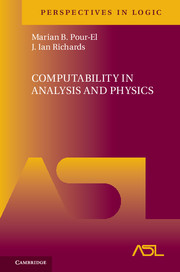Book contents
- Frontmatter
- Preface to the Series Perspectives in Mathematical Logic
- Authors' Preface
- Contents
- Maps
- Introduction
- Prerequisites from Logic and Analysis
- Part I Computability in Classical Analysis
- Chapter 0 An Introduction to Computable Analysis
- Chapter 1 Further Topics in Computable Analysis
- Part II The Computability Theory of Banach Spaces
- Part III The Computability Theory of Eigenvalues and Eigenvectors
- Addendum: Open Problems
- Bibliography
- Subject Index
Chapter 1 - Further Topics in Computable Analysis
from Part I - Computability in Classical Analysis
Published online by Cambridge University Press: 24 March 2017
- Frontmatter
- Preface to the Series Perspectives in Mathematical Logic
- Authors' Preface
- Contents
- Maps
- Introduction
- Prerequisites from Logic and Analysis
- Part I Computability in Classical Analysis
- Chapter 0 An Introduction to Computable Analysis
- Chapter 1 Further Topics in Computable Analysis
- Part II The Computability Theory of Banach Spaces
- Part III The Computability Theory of Eigenvalues and Eigenvectors
- Addendum: Open Problems
- Bibliography
- Subject Index
Summary
Introduction
This chapter starts where Chapter 0 leaves off, but involves a transition to more difficult topics. It begins with differentiation and the classes Cn, and progresses through the computable theory of analytic functions. It concludes with a general theorem on “translation invariant operators” which subsumes several of our previous results. We continue to use the “Chapter 0” notion of computability for continuous functions.
Naively, one might suppose that since the derivative, the operations of complex analysis, etc. are given by formulas, they should be computable. Of course, as we know, this is not necessarily the case. In fact, it is not always easy to guess what the results should be. Consider, for example, differentiation, the topic of Section 1. If a computable function possesses a continuous derivative, is the derivative necessarily computable? The answer turns out to be no. This raises the question: are there regularity conditions which we can impose on the initial computable function (e.g. being Cn for some fixed n, or) which insure the computability of the derivaive. Here the answer is yes. The problem is to find the right conditions.
Theorem 1, essentially due to Myhill [1971], asserts that there exists a computable C1 function whose derivative is not computable. Theorem 2, due to the authors [1983a], asserts that, on the other hand, if the initial function is C2, then the derivative is computable. Thus the cutoff point must lie somewhere between C1 and C2. Where is it located? We give a slight strengthening of Myhill's example, which shows that the function f can be twice differentiate (but not continuously so) and still give a noncomputable. Hence the cutoff is pinned between “twice differentiable” (Theorem 1) and “twice continuously differentiable” (Theorem 2).
A curious result which emerges from Theorems 1 and 2 is the following: There exists a function on [0, 1] which is effectively continuous at each point of [0, 1] but not effectively uniformly continuous on [0, 1] (Corollary 2b). Thus the classical theorem that a continuous function on a compact set is uniformly continuous does not effectivize.
Information
- Type
- Chapter
- Information
- Computability in Analysis and Physics , pp. 50 - 74Publisher: Cambridge University PressPrint publication year: 2017
